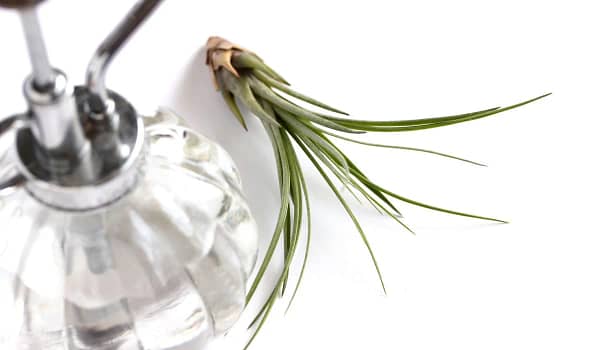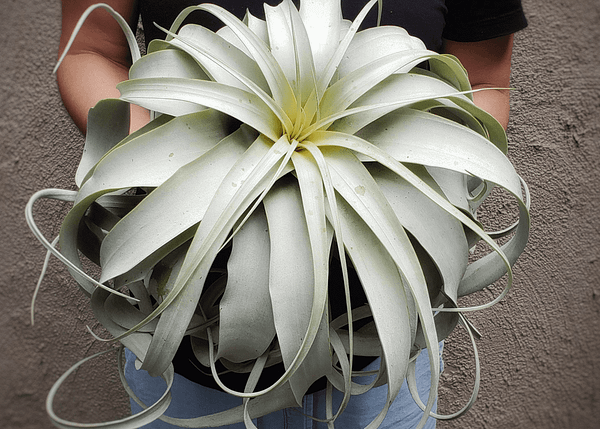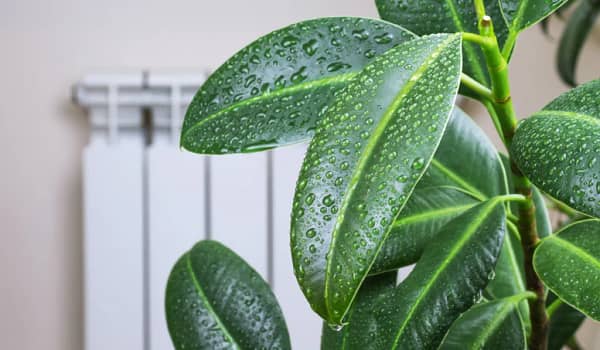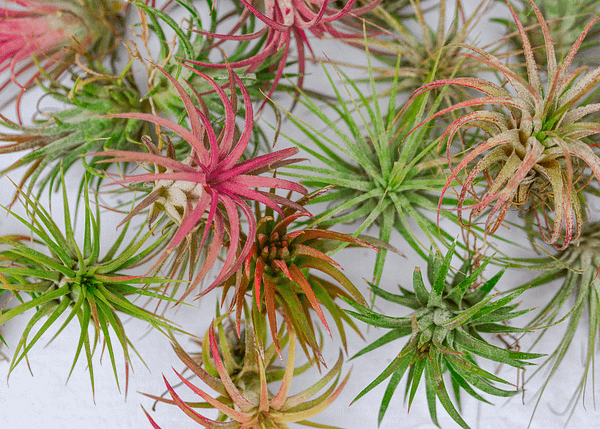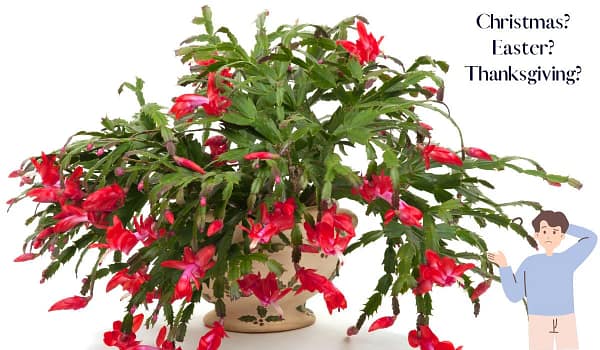All About Staghorn Fern Care

Platycerium bifurcatum / Elkhorn fern
Staghorn Ferns are gigantic, gorgeous ferns originating from Asia and Australia. These unusual houseplants get their name from the “antler” shape of their leaves. Staghorns are beloved for their leaf shape, velvet texture, and their ability to grow mounted on wood.
These ferns are epiphytic plants that grow on the bark of trees so they typically do well mounted on different types of wood. The wood plaque or driftwood is often hung on walls as decor. This allows the staghorn ferns to grow in a more natural form and adds visual interest to the room’s decor. As ferns go, these are a bit tricky to care for but they are low-maintenance plants once you get the hang of it. Jump to How to Mount Staghorn Ferns.
Not only are Staghorn ferns a decorative plant, they are also non-toxic and Pet Safe. Your dog or cat may have a little tummy upset if they ingest Staghorn Ferns but it is due to a digestive system lacking the ability to digest plants, not poison. AKA your kitty is not a cow with four stomachs made for breaking down plant material. So… the plant might come back up if you know what I mean.
Read on to learn more about caring for Staghorn Ferns ……

How To Care for Staghorn Ferns
Staghorn ferns are relatively easy to care for but there is a learning curve especially if your stag is mounted. The biggest factors are moisture, light, and humidity.
As with most ferns, Staghorns prefer consistently moist soil or substrate. You might get a pass on a few missed waterings but your plant will start suffering if it gets too dry. You also don’t want soggy, soaking-wet soil.
Staghorn Ferns need consistent bright, shade. Think about the light you receive hiking in the woods or sitting under an oak tree. This is the ideal amount of light staghorn ferns receive in the wild. If you live somewhere with humid summers, they appreciate a shady porch or perch under a large tree.
These do best in a kitchen or bathroom where the humidity is naturally higher. Often when the leaves start to brown, people will think the plant needs more water but it is actually low humidity causing the browning. Check out our humidity guide for ways to increase humidity.
You can pot them up an inch or two once the roots start growing out of the bottom of the pot or the fronds start growing over the pot. Remember that these plants are slow growing and won’t need potting up or remounting very often. Because they won’t need fresh soil as often as fast-growing plants, be sure to fertilize during the growing season so they don’t lack nutrients.
Once staghorn ferns reach maturity, growing them in pots becomes impractical and mounting or hanging will likely be necessary. I find it is better to mount them before they are mature; mounting a huge staghorn can be quite difficult. Jump to How to Mount Staghorn Ferns for more information.
Once your fern is mounted, water it by soaking the moss-covered rootball for 10-20 mins. Alternatively, you can spray it down outside (if temperatures permit) or in the shower.
Care Summary
Zone
The ideal temperature range is 60° – 100 ℉
Peperomias prefer warm, humid conditions.
Find your zone here.
Water
They don’t like to completely dry out.
Water when the top 1-2 inches of soil is dry.
If you are unsure, stick your finger in the soil.
Too much water can cause root rot
Size
These are small, compact plants.
Caperatas grow to around 1 foot wide and 5 inches tall.
Light
Bright, indirect light but can grow well in medium-light situations.
Frost loves the morning sun.
Direct sun after 11 am can cause sunburn.
Soil
Use a rich potting mix that drains well.
Incorporate small pieces of orchid bark and perlite into regular or succulent soil to create more airflow.
Compost will add much-needed nutrients.
Humidity
50% or higher humidity levels.
Native to subtropical regions.
Toxicity
Peperomia Caperata Frost is non-toxic
Safe for children and pets.
Find more pet-safe plants here.
Fertilizer
Fertilize every during the growing season.
Once every three months with Green Grub Insect Frass.
For synthetic, use an all-purpose houseplant fertilizer with a balanced ratio.
Propagation
Division
Offsets
Stem or leaf cuttings
How to Mount Staghorn Ferns

Most Staghorn Ferns will need to be mounted before they get too big. I suggest mounting once they reach a 4-6 inch pot size; however, it can be done sooner or later just not as easily. You’ll need the following items to mount your staghorn fern:
- Wood for the mount
- 2-inch screws (4-6)
- Drill
- Fishing line (30lbs)
- Sphagnum moss
- Sealant for the wood (optional)
- Scissors
1. Choose your mount. Any thin slab of wood will do, it doesn’t have to be fancy. However, the more rot-resistant the wood, the better. Driftwood also works very well and is aesthetically pleasing. Have as much fun choosing a decorative mount as it as you like! Consider the size of the wood and how much-growing room your fern will have.
2. Seal the wood (optional). Since the wood will frequently get wet and hang on the wall, it may be a good idea to seal the wood. This will help to prevent rot and warping of the wood. The downside of this is adding chemicals to the growing surface. In my experience, this does not harm the plant.
3. Use something round to trace a circle in the middle of the plaque. The circle should be roughly 2 inches larger than the rootball of your plant. If using driftwood, skip this step.
4. Drill 4-6 holes along the circle. Insert screwing leaving enough space to wrap the fishing line around them.
5. Tie off a line of the fishing line around one of the screws. This will be your starting point as you wrap the fishing line to secure your fern.
6. Take a section of damp moss and place it on the plaque, covering the circle you drew.
7. Remove loose soil from your staghorn fern and place the rootball on top of the moss.
8. Add more moss on top of the rootball.
9. Begin to wrap the fishing line from screw to screw. I find a star formation works well but it doesn’t have to be geometrical; just has to hold up the rootball.
10. Add more moss as you weave the fishing line over the moss until a solid base has formed and your staghorn fern is secure. Hold up the mount vertically to test the hold.
11. Once your mounted staghorn is secure, tie off the fishing line.

How to Propagate Staghorn Ferns
Ferns naturally propagate by spores and offsets. It’s impractical to try spore propagations in a home environment so we will focus on the division of offsets.
1. Once your plant is large enough and producing offsets you can divide it. This is easily done while repotting or mounting your plant. When you have the rootball out of the pot, use a sharp knife to cut individual offsets away from the main plant. Make sure to get enough roots to support the new offset.
2. Likewise you can also loosen the rootball with your fingers and gently separate the offset from the main plant.
3. Plant your new offset into a rooting medium, keep moist and wait for the plant to establish.
4. Once your offset is established and growing well. Repot into a pot that is 1 inch larger than the rootball and enjoy your new plant!
Get your very own Staghorn Fern here.














